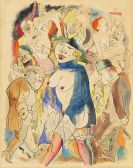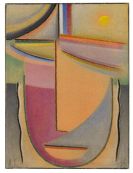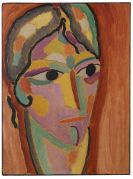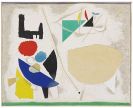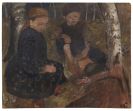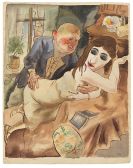
Max Ackermann
Berlin
1887 -
Unterlengenhardt
1975
At first, Max Ackermann studied in Henry van der Velde's studio in Berlin and at Gotthardt Kuehl's in Dresden. From 1905 to 1909, he went on to Munich to continue his studies at the academy in Franz von Stuck's painting class. In 1912 at the age of 25, he met the painter Adolph Hölzel, who introduced Ackermann to non-representational painting and turned out to have a formative influence on his future works. From 1912 into the 1940s Ackermann continued to paint representational art and abstract works. In 1924 his first solo exhibition of figurative and abstract paintings, pastels and drawings was held at the 'Kunstgebäude Stuttgart'. In 1921 the artist met Rudolf von Laban, the founder of abstract dance, with whom he entered into a vivid discussion about dance notation and counterpoint, inspiring Ackermann to rhythmic blind paintings. In his studio Ackermann set up the 'Lehrwerkstätte für Neue Kunst' and held holiday seminars for young art teachers. In 1930 Max Ackermann introduced a seminar on 'absolute painting'. Three years later he presented lectures based on these seminar topics at a Hölzel exhibition in the Stuttgart gallery 'Valentien'. When he was banned from teaching in 1936, Ackermann moved back to Hornstaad at Lake Constance - which was to become a painters' colony. Helmuth Macke, Otto Dix and Erich Heckel also settled there. In 1939 many of his early works perished in the flames when his studio was destroyed by bombs. After the war, Ackermann presented his works in an exhibition at the 'Salon des Réalité' in Paris. Furthermore the artist contributed to the 1949 Zurich exhibition 'Kunst in Deutschland 1930-49'. In 1952, together with Wolfgang Fortner, Ackermann held a seminar on painting and music. One year later, he headed a further event on the issue of painting and architecture together with Hugo Häring and Kurt Leonhart. In 1956, the southern German artists' association 'Künstlerbund Baden-Württemberg' appointed Ackermann to the 'Rat der Zehn' as successor to the deceased Willi Baumeister. A retrospective exhibition in 1967 brought the artist's works from 1908 to 1967 to the German cities of Koblenz, Kaiserslautern, Constance, Wolfsburg and Cologne. Max Ackermann died in 1975 at the age of 88.
Would you like to sell a work by Max Ackermann?
Infos for seller


